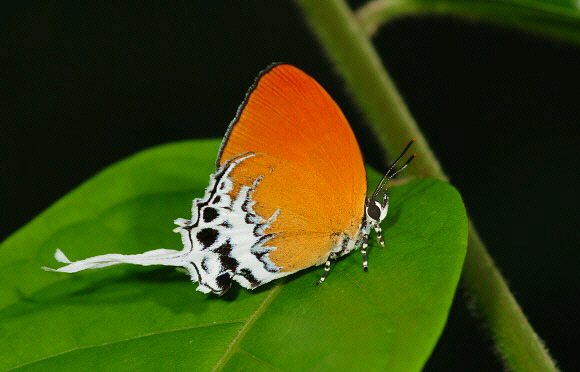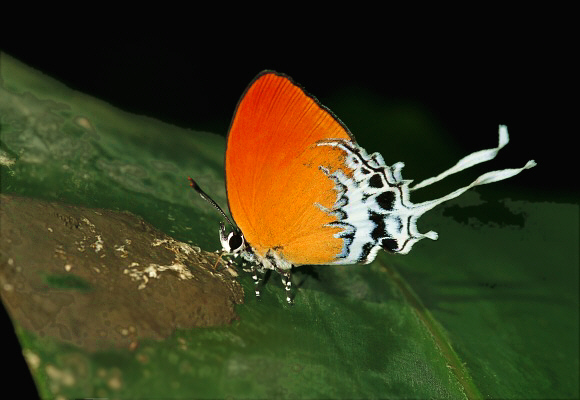
Introduction
The Theclinae (Hairstreaks) are found worldwide, with about 270 representatives in Sundaland, the region that encompasses the Malay peninsula, Borneo, Sumatra, Java, and Palawan.
There are several genera which contain species with long tails, orange undersides, and black and white markings in the distal area, including Thamala, Eooxylides, Drupadia, Cheritra, Neocheritra, Thrix, and Zeltus.
Eooxylides tharis is certainly one of the most beautiful species from the genera listed above. It is recognized by its particularly brilliant orange underside coloration, very distinctive markings, and extraordinarily long and twisted tails. The upperside wings are blackish brown, with broken white markings in the distal area of the hindwings.
There are arguably 11 species of Eooxylides, although many workers regard the majority of these as being subspecies of tharis, occurring variously in Thailand, West Malaysia, Singapore, Borneo, Sumatra, Palawan, Java, and some of the smaller islands of Indo-China. Most authorities, however, agree that etias from Borneo, and meduana from the Philippines are distinct species.
Habitats
This species is found in wet rainforest areas at elevations between sea level and about 1000m.
Lifecycle
In August 2004 at Tapah Hills in Malaysia, I observed a female ovipositing on a woody sprig at the side of a forest road. The eggs were white and were laid in loose clusters of about 10-15, wrapped around the tip of the sprig, about 0.5m above ground level. I was unable to determine the species of plant. The only recorded larval foodplant is Smilax bracteata, a common forest vine.
The larva is green, suffused on the thorax and at the tail end with red. It is smooth-skinned, ovoid, flattened, and has what could be described as a lip or rib around its lower half, enabling it to squat limpet-like to its substrate, with its legs completely hidden. This strongly suggests that it needs to protect its soft undersurface from the ants which attend it. (Seufert & Fiedler found that about 50% of tharis larvae were attended by ants). The green pupa has the wing cases suffused with white at their base, and with reddish around the wing edges.

Adult behaviour
The butterfly tends to skip purposefully from perch to perch, searching for food sources which include bird droppings and aphid secretions. Once settled they are usually reluctant to move, and oblivious to human disturbance, particularly if they are feeding.
Males are commonly found in small groups of about 3 or 4 on the stems of bushes in shady areas of disturbed forest, having been attracted by the sweet “honey-dew” secretions produced by aphids and membracids. At such sites there are invariably at least a dozen ants sharing their meal, but the ants do not molest the butterflies, which are possibly protected by their chemical properties. When feeding they habitually walk around the stems, each butterfly slowly rotating on its own axis as it avidly probes the sugary secretions with its proboscis. On more than one occasion, I’ve found males head-locked together, apparently the result of an eagerness to feed, rather than aggression.
Females are usually encountered singly when searching for oviposition sites.
